The city that roads forgot – an expert guide to Iquitos, the capital of the Peruvian Amazon
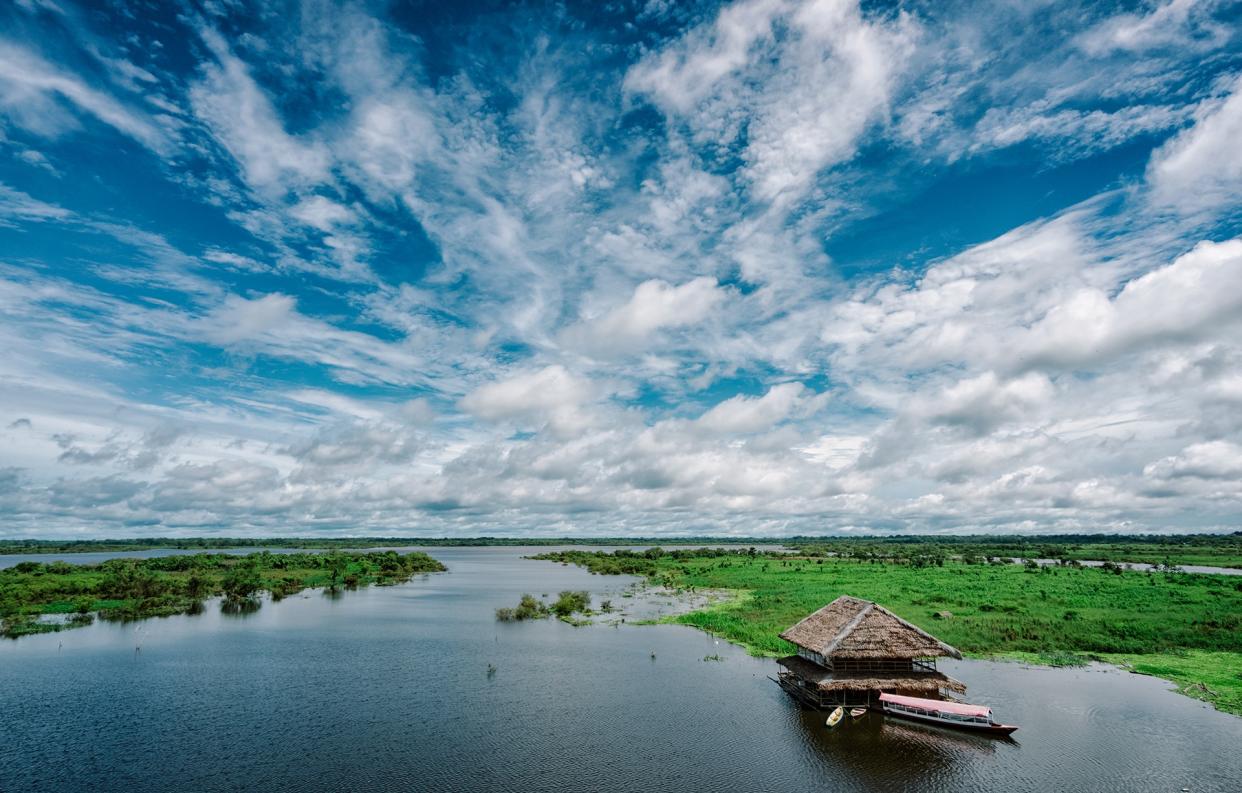
Why go?
Deep in the Amazon jungle, bankside the mighty Amazon River, 2,236 miles (3,600km) from its mouth, Peru’s Iquitos – the largest city in the world inaccessible by road – is the closest thing the Amazon has to a capital. Founded by Jesuit Missionaries in 1730, made rich by the brutal rubber boom of the 19th century, Iquitos has found fame in the 21st century as the most popular departure point for Amazon jungle and river adventures.
Cruise port location
What Iquitos lacks in roads, it makes up for in ports. The Amazon – at this point approximately 1.4 miles (2km) across – is a teeming network of tributaries and traffic with speedboats, cruise liners, cargo ships and canoes navigating this epic waterway.
Puerto Bellavista-Nanay at the northern tip of town is an unprepossessing stretch of waterfront used by smaller vessels journeying to nearby locations, and by larger cruise ships when water levels are low. The most popular cruise ship ports – Puerto Masusa and Puerto ENAPU – stretch along Avenida La Marina just north of the city centre. Many cruise ships heading for the spectacular Reserva Nacional Pacaya Samiria depart from the town of Nauta – 62 miles (100km) to the south via the region’s only road.
Can I walk to any places of interest?
Whatever the season in which you dock, Iquitos will be hot, humid and, quite possibly, flooded. While it’s feasible to walk the two or three kilometres from Puerto Masusa or Puerto ENAPU to the historic Plaza de Armas in the city centre, public transport abounds and is by far the most preferable way to get around.
Getting around
The lack of roads leading to the city have been no barrier congestion: motorcycles and auto rickshaws (popularly known here as motokars) swarm the streets like giant irate insects, the racket from which has led to Iquitos being ranked the noisiest city in Latin America. However, despite the decibels, it is also one of the easiest cities to zip around, since you are generally only moments away from an empty motokar. During the wet season when parts of the city become flooded, and for destinations outside the city limits, a boat is needed, of which there are a multitude of options.
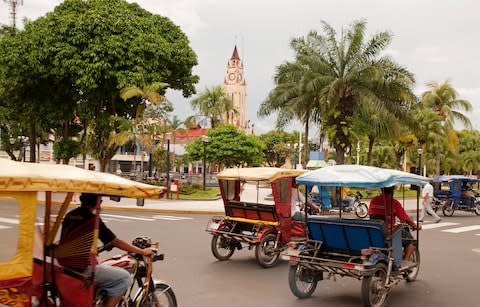
What to see and do
While most people visiting Iquitos head straight for the jungle, the river or on retreat (the surrounding jungle is home to the highest concentration of ayahuasca clinics in the world), Iquitos is Peru’s sixth largest city and has a unique cultural identity that is not to be missed.
What can I do in four hours or less?
Start your tour at the Plaza des Armas, which owes much of its former splendour to the rubber boom years (1879 to 1912), during which enslaved Amerindians tapping black gold brought stupendous wealth to their European overlords – a time reimagined in Werner Herzog’s iconic film Fitzcarraldo. Opposite the impressive Iquitos Cathedral sits the city’s most distinctive building, the Casa de Fierro, an ironclad pre-fab that was erected during the rubber boom. Purchased by rubber baron Anselmo del Aguila at the International Exposition of Paris in 1889, its journey across the Atlantic and up the Amazon River is as impressive as the structure itself. Rumour has it – false it would seem – that the building was designed by Gustave Eiffel. For an altogether more magical origin myth, read Peruvian Nobel laureate Mario Vargas Llosa’s comic masterpiece Captain Pantoja and the Special Service.
One block south sits one of the rubber boom’s most opulent buildings, the Ex Hotel Palace. Built at the turn of the twentieth century, this modernist masterpiece was the place to stay during the waning days of the boom. Today it houses the Peruvian military, so the interior is sadly inaccessible. Follow the Malecón south and you hit two of the city’s best museums: Museo de Culturas Indígenas Amazónicas and the Museo Etnográfico. Though small, each pays tribute to the diversity of Amazonian culture and history that dominates this region. In the latter, don’t miss the ayahuasca-inspired hallucinogenic art.
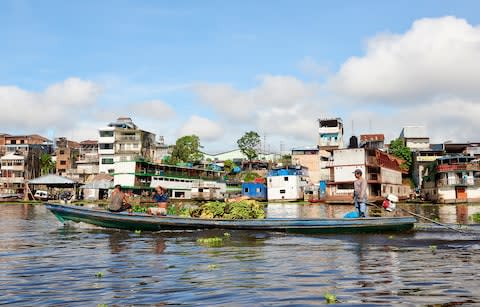
Finish up by hitting the beach at the pleasant Laguna de Quistococha, which lies just beyond the airport. On sunny days, locals crowd this stretch of white sand studded with food stalls and find refuge from the heat in the lake. Skip the zoo, in which native species are crammed in dank enclosures, a wall away from their natural habitats.
What can I do in eight hours or less?
Most people come to Iquitos in search of nature, and you don’t have to head too far out of the city to find yourself a world away from its cacophony. One of the most popular day trips is to the Pilpintuwasi Butterfly Farm, 2.5 miles (4km) up the Nanay River by boat from the Puerto Bellavista-Nanay. Though primarily a breeding centre for a panoply of Amazonian butterflies, the farm is also home to a number of orphaned animals, including a tapir, an anteater and Pedro Bello, the jaguar.
Another popular animal rescue centre is La Isla de los Monos, an idyllic isle dedicated to the conservation of monkeys rescued from the pet trade an hour upriver on the Amazon. The organisation’s city centre travel agency is the best place to book tours to the island – which can range from eight hours to a week.
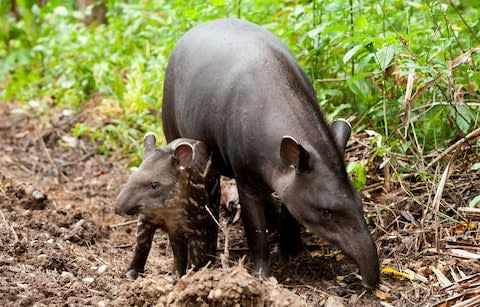
Golfing enthusiasts will want to head straight for the nine-hole Amazon Golf Course, the only fairway for thousands of miles around. Cut out of the jungle on the edge of the city, this is about as far from Augusta as you can find. With greens resembling the rough, and the rough nearly impenetrable, the charming staff and unparalleled location make up for the course being somewhat under par. All equipment can be hired; expect to lose a few balls.
What can I do with a bit longer?
Those staying longer will want to venture to some of the eco lodges in the heart of the Amazon rainforest, visiting isolated Amerindian communities on the way and discovering the wealth of plant, fish, animal and insect life that crams the most densely-packed ecosystem on earth. And for this you will most certainly need a guide. Iquitos teams with jungle expedition outfits. One of the best is the government-run iPerú with counters at the airport and in the city centre.
Eat and drink
The enormous exotic larder that is the Amazon rainforest gives Iquitos its vast and unique cuisine. Wrapped in leaves, pierced on a stick, drinks from a bag – much of the best fare can be found on the numerous street stalls in the city. Central to any tasting menu is juane: a ball of rice, meat, olives and egg the size and shape of a grapefruit wrapped in leaves and steamed. Doncella – the local catfish – should top the menu for pescatarians, while the adventurous will want to tuck into a skewer of suri, the barbequed larvae of the palm weevil that is ubiquitous and prized.
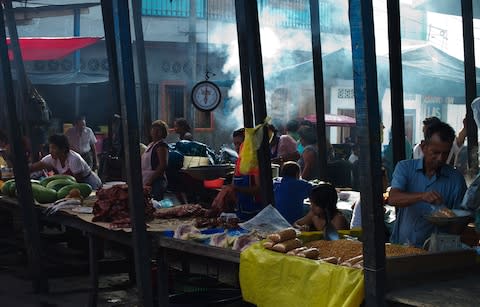
Superfoodies will want to sup on the juice of agauje and camu camu – the latter reputedly containing the highest natural source of vitamin C found thus far. The Witch’s Market in the barrio of Belen sells a host of shamanic herbal remedies, most of which purport to be aphrodisiacal.
Iquitos is a town where anything goes, and tourists are often tempted by some of the exotic meat that is frequently touted to tourists. Don’t be. Not only is this a fast-track to finding yourself in need of the limited medical facilities on offer, but much of the prized game on display is endangered.
Don’t leave the city without…
Amazonian pop art. Emerging in the late 1990s and inspired by ayahuasca trips and a whole gamut of international new age influences, these dark canvases etched with phosphorescent ink have become indicative of the culture of the Peruvian Amazon. The best place to browse is the Mercado Artesanal of San Juan.
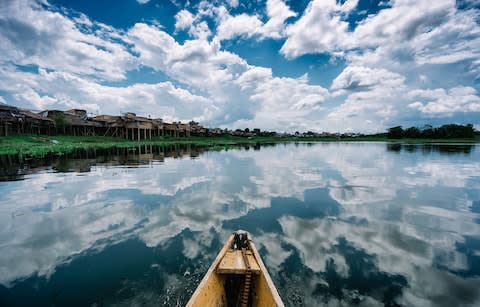
Need to know
Flight time from the UK
There are no direct flights between London and Iquitos. Flights transfer through Peru’s capital, Lima, with flight times that can hit 20 hours.
Best time to go
Iquitos is a rainy city: whatever the season, expect frequent downpours. The official rainy season runs from November until May, with March and April seeing the brunt of the rain. In May, the Amazon reaches its highest levels – up to 12 metres above its lowest point in October. June to October, the driest months, tend to be the best months to travel.
Safety
Iquitos is generally safe, though rife with pickpockets. Never book tours with touts on the street: they will likely rip you off or rob you. Stick to recognised tour agencies. Ayahuasca retreats are unregulated, and the drug can react badly with existing medical conditions. Medical facilities in this region are basic.
Closures
Attractions in Iquitos are open for business every day of the week.

